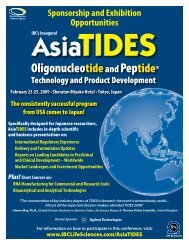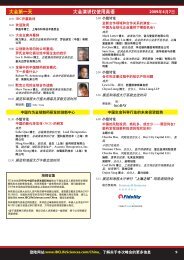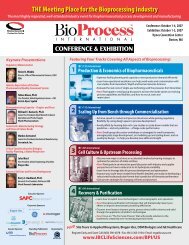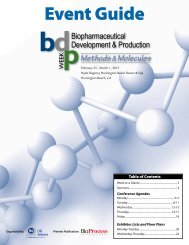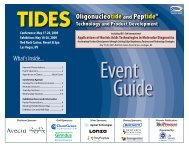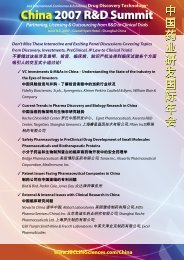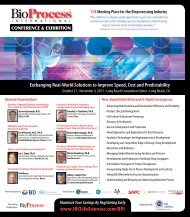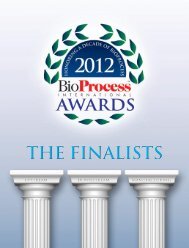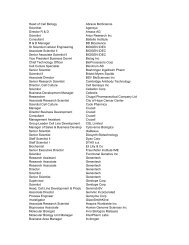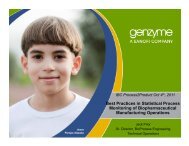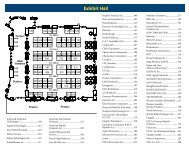Register Early and Save up to $300 (See page ... - IBC Life Sciences
Register Early and Save up to $300 (See page ... - IBC Life Sciences
Register Early and Save up to $300 (See page ... - IBC Life Sciences
You also want an ePaper? Increase the reach of your titles
YUMPU automatically turns print PDFs into web optimized ePapers that Google loves.
Thursday, September 23, 2010 • Main Conference<br />
12:00 Concurrent Technology Workshops<br />
Hybrid Purification – The Next Generation of Cell Clarification<br />
Cell clarification in the biopharmaceutical industry has long been dominated by adsorptive<br />
depth filtration. Traditional cellulose-based depth filters feature natural materials that<br />
are prone <strong>to</strong> variation in performance <strong>and</strong> extractable profile. This workshop will present<br />
an overview of a fully synthetic “hybrid purifier” that is being designed <strong>to</strong> increase flexibility in cell clarification,<br />
minimize performance variation <strong>and</strong> improve overall process efficiency both <strong>up</strong>stream <strong>and</strong> downstream.<br />
Thomas P. O’Brien, Ph.D., Senior Applications Specialist, 3M Purification Inc<br />
Cell Culture Media Platform for the Rapid Production of<br />
Gram Quantities of Recombinant Antibodies from CHO<br />
Cells Transformed with the Selexis Vec<strong>to</strong>rs<br />
Results from a collaborative program between Irvine Scientific, CA.,<br />
USA <strong>and</strong> Selexis, S.A., Geneva, Switzerl<strong>and</strong> will be presented.<br />
Tom Fletcher, Direc<strong>to</strong>r, Cell Culture R&D, Irvine Scientific<br />
Pierre-Alain Girod, Ph.D., Chief Scientific Officer, R&D, Selexis SA, Switzerl<strong>and</strong><br />
Multi-Fold Titer Improvement through Integrated<br />
Medium <strong>and</strong> Feed Design<br />
High cell densities <strong>and</strong> product yields require culture media <strong>and</strong> feeds formulated so that<br />
no one nutritional component becomes limiting. Integration of the basal medium <strong>and</strong> feed<br />
design ensures nutrient availability. IgG titers of 2.6 g/L were reached using an integrated design strategy compared<br />
with starting titers of 0.5 g/L. This represents a 10-fold improvement over batch culture. Potential challenges <strong>and</strong><br />
solutions will be discussed.<br />
Shawn Barrett, Senior Manager, R&D, Invitrogen, part of <strong>Life</strong> Technologies<br />
POROS® XS: A High Capacity, High Resolution CEX Resin<br />
The features <strong>and</strong> performance of POROS® XS chroma<strong>to</strong>graphy resin will be highlighted. The benefits<br />
of a high capacity, high resolution, salt <strong>to</strong>lerant CEX resin as they relate <strong>to</strong> improving downstream<br />
purification process performance <strong>and</strong> productivity will be proposed. Applications data <strong>and</strong> process productivity modeling<br />
will be used <strong>to</strong> demonstrate the benefits of utilizing POROS XS.<br />
Christine Gebski, M.S., Direc<strong>to</strong>r, POROS Applications <strong>and</strong> R&D, Applied Biosystems, part of <strong>Life</strong> Technologies<br />
12:30 Networking Luncheon in Exhibit <strong>and</strong> Poster Hall<br />
1:00 Featured Presentation in Exhibit <strong>and</strong> Poster Hall<br />
The Enduring Need for Operational Excellence: Lessons Learned from the Oil Field <strong>to</strong> Biotech <strong>and</strong> How Great Companies can Still Fall Short<br />
BP’s oil disaster in the Gulf shows how decisions <strong>and</strong> events can impact global organizations. Genzyme was hit with a virus that was undetectable by the industry’s st<strong>and</strong>ard viral tests <strong>and</strong> led <strong>to</strong> a global shortage in s<strong>up</strong>ply of critical<br />
medicines. During this presentation, Mark Bamforth will reflect on the importance of relentlessly pursuing Operational Excellence <strong>and</strong> how events can still impact an organization.<br />
Mark R. Bamforth, President & CEO, Gallus Biopharmaceuticals; Former Senior Vice President, Corporate Operations <strong>and</strong> Pharmaceuticals, Genzyme Corporation<br />
Recovery & Purification<br />
1:45 Chairperson’s Remarks<br />
Uwe Gottschalk, Ph.D., Vice President, Purification Technology, Sar<strong>to</strong>rius Stedim<br />
Biotech, Germany<br />
Implementing the Latest Tools <strong>and</strong> Techniques<br />
<strong>to</strong> Optimize the Harvest Step<br />
2:00 Optimization of the Harvest Step<br />
Cell culture harvest often involves centrifugation <strong>and</strong> filtration operations. The<br />
requirements for the filters depend on the size <strong>and</strong> amount of particles which remain<br />
suspended in the broth after centrifugation. Particle-size analysis of bench<strong>to</strong>p<br />
centrifuge clarification runs gives information which can be used for specification of<br />
the filters <strong>and</strong> for optimization without needing <strong>to</strong> gather data at the production scale.<br />
Roy Hegedus, Ph.D., Senior Scientist, Purification, Process <strong>Sciences</strong>,<br />
Abbott Bioresearch Center<br />
2:30 Enabling Precipitation as an Operation <strong>to</strong> Manage Critical<br />
Contaminants in Bioprocessing<br />
Precipitation is a versatile technique for contaminant removal <strong>and</strong> product capture<br />
but not commonly used in the production of biologics. Reasons cited for this<br />
surround difficulty in finding the desired yield <strong>and</strong> purity. This dogma is removed<br />
if we adopt techniques <strong>to</strong> accelerate this search process, enabling evaluation of the<br />
large design spaces that result from combinations of precipitation agents.<br />
Daniel G. Bracewell, Ph.D., M.S., Department of Biochemical Engineering,<br />
University College London, United Kingdom<br />
3:00 Exploring Exp<strong>and</strong>ed Bed Adsorption for Capture of Antibodies<br />
from CHO Cultures<br />
A New Protein A based exp<strong>and</strong>ed bed adsorption chroma<strong>to</strong>graphy media<br />
was examined as a method of capture for monoclonal antibodies from CHO<br />
cell cultures. Purification performance of this resin was examined relative <strong>to</strong><br />
conventional protein A chroma<strong>to</strong>graphy. Capacity, cleaning alternatives, <strong>and</strong><br />
stability of the resin in cleaning <strong>and</strong> s<strong>to</strong>rage solutions are examined.<br />
Richard S. Wright, Principal Research Scientist, Pfizer Biotherapeutics<br />
3:30 Networking Refreshment Break in Exhibit <strong>and</strong> Poster Hall<br />
Overcoming Challenges of Production, Purification<br />
<strong>and</strong> Characterization of Next Generation<br />
Antibody-Like Molecules & Protein Therapeutics<br />
4:00 CASE STUDY Investigation in<strong>to</strong> the Concentration Limit of a<br />
PEGylated Protein<br />
This study illustrates concentration limitations for a mono PEGylated protein. The<br />
desired PEGylated protein concentration was 60mg/ml but only 24 mg/ml was achieved<br />
by UF/DF. We demonstrated that the protein could be concentrated <strong>to</strong> >60mg/ml while<br />
linear PEG could be concentrated <strong>to</strong> 25 or 35 mg/ml in formulation buffer or WPU,<br />
respectively, demonstrating that PEG was the limiting concentration fac<strong>to</strong>r.<br />
Sarah Holtschlag, M.S., Senior Scientist, Downstream Process Development,<br />
Diosynth Biotechnology<br />
4:30 Assembly <strong>and</strong> Purification of Knob <strong>and</strong> Hole Bispecific Antibodies<br />
Abstract not available at press date. Please visit www.<strong>IBC</strong><strong>Life</strong><strong>Sciences</strong>.com/BPI<br />
for <strong>up</strong>dates.<br />
Josefine Persson, Ph.D., Scientist, <strong>Early</strong> Stage Purification, Genentech, Inc.<br />
5:00 Applications for Biopharmaceuticals in Regenerative Medicine<br />
Many biopharmaceuticals <strong>and</strong> biological products are designed <strong>to</strong> block disease<br />
pathways or replace missing fac<strong>to</strong>rs but there is a growing interest in their<br />
application <strong>to</strong> regenerative medicine wherein biological systems are res<strong>to</strong>red <strong>to</strong><br />
their healthy state. This presentation will discuss some of the manufacturing <strong>and</strong><br />
analytical challenges that are specific <strong>to</strong> products for regenerative medicine.<br />
Peter W. Wojciechowski, Ph.D., Direc<strong>to</strong>r, Product <strong>and</strong> Process Development,<br />
Advanced Technologies <strong>and</strong> Regenerative Medicine, LLC (ATRM)<br />
5:30 Immunodrugs TM – Development of a New Class of<br />
Therapeutic Vaccines<br />
Cy<strong>to</strong>s Biotechnology is developing a new class of vaccines (Immunodrugs TM )<br />
targeting several indications including major chronic diseases. By highly repetitive<br />
presentation of disease-related proteins on the surface of virus like particles (VLPs),<br />
Immunodrugs TM elicit a potent immune response against said disease-related<br />
proteins with the potential <strong>to</strong> offer therapeutic benefits. The concept, production<br />
<strong>and</strong> application of Immunodrugs TM will be presented.<br />
Frank Hennecke, Ph.D., Executive Vice President, Product Development,<br />
Cy<strong>to</strong>s Biotechnology, Switzerl<strong>and</strong><br />
6:00 Close of Day<br />
Interested in sending a team<br />
Take advantage of discounted gro<strong>up</strong> rates for 3 or more.<br />
For more information, contact 646-895-7445<br />
Cell Culture & Upstream Processing<br />
1:45 Chairperson’s Remarks<br />
Kevin J. Kayser, Ph.D., Associate Direc<strong>to</strong>r, Cell <strong>Sciences</strong> <strong>and</strong> Development, SAFC<br />
Host Cell Engineering <strong>to</strong> Improve the Yield<br />
<strong>and</strong> Quality of Biotherapeutics<br />
2:00 Proven Approaches <strong>to</strong> Determine Manufacturability of<br />
C<strong>and</strong>idate Molecules<br />
An early determination of the manufacturability of biological molecules is crucial<br />
for the successful development of biotherapeutics. This assessment begins with an<br />
evaluation of the drug-like properties of c<strong>and</strong>idate molecules <strong>and</strong> continues with<br />
the development of cell line <strong>and</strong> downstream processing. This presentation will<br />
explore analytical approaches for the selection of the most suitable immunoglobulin<br />
molecules for development as biotherapeutics.<br />
Czeslaw Radziejewski, Ph.D., Senior Gro<strong>up</strong> Leader, Protein Analytics,<br />
Abbott Bioresearch Center<br />
2:30 Profiling Highly Conserved MicroRNA Expression in Chinese<br />
Hamster Ovary Cells <strong>and</strong> Its Applications in Cell Engineering<br />
We used microRNA array <strong>and</strong> quantitative RT-PCR <strong>to</strong> profile highly conserved<br />
microRNA expression in CHO cells. miR-221, miR-222, miR-125b, miR-19a <strong>and</strong> let-<br />
7b were differentially expressed in IgG producing lines. We also investigated miR-24<br />
expression in CHO cell lines with different DHFR genotypes. The results represent<br />
initial effort <strong>to</strong>wards underst<strong>and</strong>ing miRNA expression in CHO cells <strong>and</strong> <strong>to</strong>wards<br />
using miRNAs in cell engineering.<br />
Nan Lin, Principal R&D Scientist, Cell <strong>Sciences</strong> <strong>and</strong> Development, Sigma-Aldrich<br />
3:00 Use of RNAi <strong>to</strong> Transform Biotherapeutics<br />
RNAi technology can be utilized in bioprocessing <strong>to</strong> reduce levels of proteins<br />
in cellular pathways that impact biotherapeutic quality, activity, <strong>and</strong> specific<br />
productivity. 1 nM siRNA added directly <strong>to</strong> 40L of CHO cells reduced levels of a<br />
selected protein >80%. This approach is amenable <strong>to</strong> existing cell lines, <strong>and</strong> the<br />
expression of multiple proteins can be reduced simultaneously.<br />
David Kocisko, Ph.D., Principal Scientist, Alnylam Biotherapeutics<br />
3:30 Networking Refreshment Break in Exhibit <strong>and</strong> Poster Hall<br />
Implementation of Novel Media Development<br />
<strong>and</strong> Feed Strategies<br />
4:00 CASE STUDY Learning from High-Performance Chemically-<br />
Defined Media Formulations for CHO Platform Processes<br />
Chemically-defined media without hydrolysates were developed <strong>and</strong> compared for<br />
a platform fed-batch process <strong>and</strong> enhanced fed-batch processes. The development<br />
<strong>and</strong> implementation approach will be described. Key features will be presented<br />
including media component effects on performance <strong>and</strong> product quality. In addition,<br />
manufacturability aspects on implementing the platform process media will be described.<br />
Masaru Shira<strong>to</strong>ri, Ph.D., Engineer II, Late Stage Cell Culture, Genentech, Inc.<br />
4:30 How Media Optimization Impacts Quality<br />
Maintaining quality comparability while maximizing productivity creates constant<br />
challenges for bioprocess development. The effect of culture media on cell<br />
performance <strong>and</strong> product quality was investigated for antibodies with established<br />
quality profiles. Media composition impacted cell growth, productivity <strong>and</strong> posttranslational<br />
modifications. The results provide guidance for further correlation<br />
between media <strong>and</strong> product quality.<br />
Zhaohui Geng, M.D., M.S., Principal Scientist, Cell Process Development,<br />
Pfizer Biotherapeutics<br />
5:00 From Hydrolysates <strong>to</strong> Unique Molecules: Identification of<br />
Bioactive Components<br />
S<strong>up</strong>plementation of cell culture media with hydrolysates has replaced serum <strong>to</strong><br />
increase cell viability <strong>and</strong> productivity of recombinant bio-therapeutics. Although<br />
hydrolysates are a better option than animal-derived serum, they are still a<br />
biologically-based raw material with potential <strong>to</strong> add variability <strong>and</strong> risk <strong>to</strong> an<br />
already complex bioprocess. Deconstruction of hydrolysates using chroma<strong>to</strong>graphy,<br />
peptide sequencing, <strong>and</strong> other biochemical techniques has allowed our team <strong>to</strong> utilize<br />
high resolution analysis techniques, such as LC-MS <strong>and</strong> GC-MS <strong>to</strong> identify unique<br />
components. DoE of these identified molecules has resulted in the formulation of<br />
a chemically-defined animal-free component s<strong>up</strong>plement that provides the cell<br />
productivity properties of a hydrolysate in mammalian cell culture.<br />
Elizabeth Dodson, Ph.D., R&D Manager, BioAnalytical Chemistry Bionutrients<br />
R&D, BD Biosciences - Advanced Bioprocessing<br />
5:30 Chemically-Defined Cell Culture Platform Development for<br />
Therapeutic Antibody Production<br />
We have developed a protein-free chemically-defined fed-batch process which could<br />
s<strong>up</strong>port cell growth at high cell density across several Abbott cell lines. The antibody<br />
titer produced from this CD process is comparable <strong>to</strong> the existing hydrolysate-based cell<br />
culture platform. To further optimize the process, we have applied genetic <strong>and</strong> metabolic<br />
analyses <strong>to</strong> identify key nutrients <strong>and</strong> possible limitations on cell growth <strong>and</strong> productivity.<br />
John Fann, Ph.D., Senior Gro<strong>up</strong> Leader, Cell Culture, Process <strong>Sciences</strong>,<br />
Abbott Bioresearch Center<br />
6:00 Close of Day<br />
Strategy Discussion<br />
Forums<br />
1:45 Development <strong>and</strong><br />
Manufacturing Strategies<br />
for Biosimilars Products<br />
Topics for discussion:<br />
• Status of US regula<strong>to</strong>ry framework<br />
• Role of contract manufacturing<br />
organizations in biosimilars<br />
• Lessons learned from Europe<br />
• Managing regula<strong>to</strong>ry <strong>and</strong> market<br />
uncertainties in the Biosimilars sec<strong>to</strong>r<br />
Modera<strong>to</strong>r:<br />
Thomas J. V<strong>and</strong>en Boom, Ph.D.,<br />
Vice President, Global Biologics R&D,<br />
Hospira, Inc.<br />
Panelists:<br />
Parrish M. Galliher, Founder <strong>and</strong><br />
Chief Technology Officer, Xcellerex, Inc.<br />
Stanley S. S. Hong, Ph.D., Senior<br />
Vice President, Head of Research &<br />
Development, Celltrion, Inc., Korea<br />
Friedrich Nachtmann, Ph.D.,<br />
Head, Biotech Cooperations,<br />
S<strong>and</strong>oz Biopharmaceuticals, Austria<br />
Curran Simpson, Senior<br />
Vice President, Operations,<br />
Human Genome <strong>Sciences</strong>, Inc.<br />
Play an active role in<br />
this conference by<br />
showcasing your results<br />
in a poster display.<br />
Did you know that 85% of our<br />
conference attendees stated that<br />
reviewing posters is one of the most<br />
important features of our events Get<br />
your research in front of your peers <strong>and</strong><br />
make your mark in this industry – gain<br />
the visibility you need <strong>to</strong> find exciting<br />
new opportunities in your company or<br />
your career.<br />
Justify Your Trip – presenting a poster<br />
at a scientific conference helps justify<br />
the time <strong>and</strong> cost for you <strong>to</strong> attend<br />
the conference. Not only are you<br />
attending the conference <strong>to</strong> learn new<br />
techniques <strong>and</strong> strategies, but you<br />
are also gaining for yourself <strong>and</strong> your<br />
company well-deserved recognition for<br />
innovative research findings, successful<br />
business models, unique service<br />
propositions, or creative business<br />
strategies.<br />
Share – this is your opportunity <strong>to</strong><br />
offer your experience, expertise <strong>and</strong><br />
insights <strong>to</strong> fellow colleagues <strong>and</strong><br />
potential partners.<br />
Gain Recognition – all posters will be<br />
displayed for attendees, exhibi<strong>to</strong>rs, <strong>and</strong><br />
presenters <strong>to</strong> see during exhibit hall<br />
hours <strong>and</strong> networking functions.<br />
The deadline <strong>to</strong> submit an abstract<br />
for inclusion in the BioProcess<br />
International Magazine September<br />
Issue Pre-Show Event Guide Insert is<br />
August 4th, 2010. (Abstract <strong>and</strong> full<br />
payment of conference <strong>and</strong> poster fees<br />
must be received by this date.) The size<br />
of the poster board is 4'x8'. Please note:<br />
Poster presentations may not be used<br />
as exhibit displays or for marketing<br />
purposes. All posters are subject <strong>to</strong><br />
approval by conference organizers.<br />
The deadline <strong>to</strong> submit an abstract<br />
for inclusion in the conference<br />
documentation is August 20,<br />
2010 (Abstract <strong>and</strong> full payment of<br />
conference <strong>and</strong> poster fees must<br />
be received by this date.) After that<br />
date posters are on a space available<br />
basis. To submit your poster <strong>and</strong> for<br />
additional details on the poster sizes<br />
<strong>and</strong> regulations, please visit<br />
www.<strong>IBC</strong><strong>Life</strong><strong>Sciences</strong>.com/BPI<br />
Visit www.<strong>IBC</strong><strong>Life</strong><strong>Sciences</strong>.com/BPI for <strong>up</strong>-<strong>to</strong>-date information on this event 10





